Marketing Research Proposal for D.A. Supplies: Comprehensive Analysis
VerifiedAdded on 2021/05/31
|7
|1550
|4152
Report
AI Summary
This report presents a marketing research proposal for D.A. Supplies, focusing on the preliminary project scope. It outlines the research design, which adopts a cross-sectional survey approach, and details the target population and sampling techniques. The proposal also discusses data collection instruments, including the use of closed-ended questionnaires, and procedures for ensuring the validity and reliability of the research. Furthermore, the report specifies the statistical software, SPSS, to be utilized for data analysis, including descriptive and inferential statistics. The study aims to investigate the relationship between declines in sales and customer satisfaction, providing recommendations for D.A. Supplies based on the findings. The report also includes a list of cited references supporting the research methods and concepts discussed.
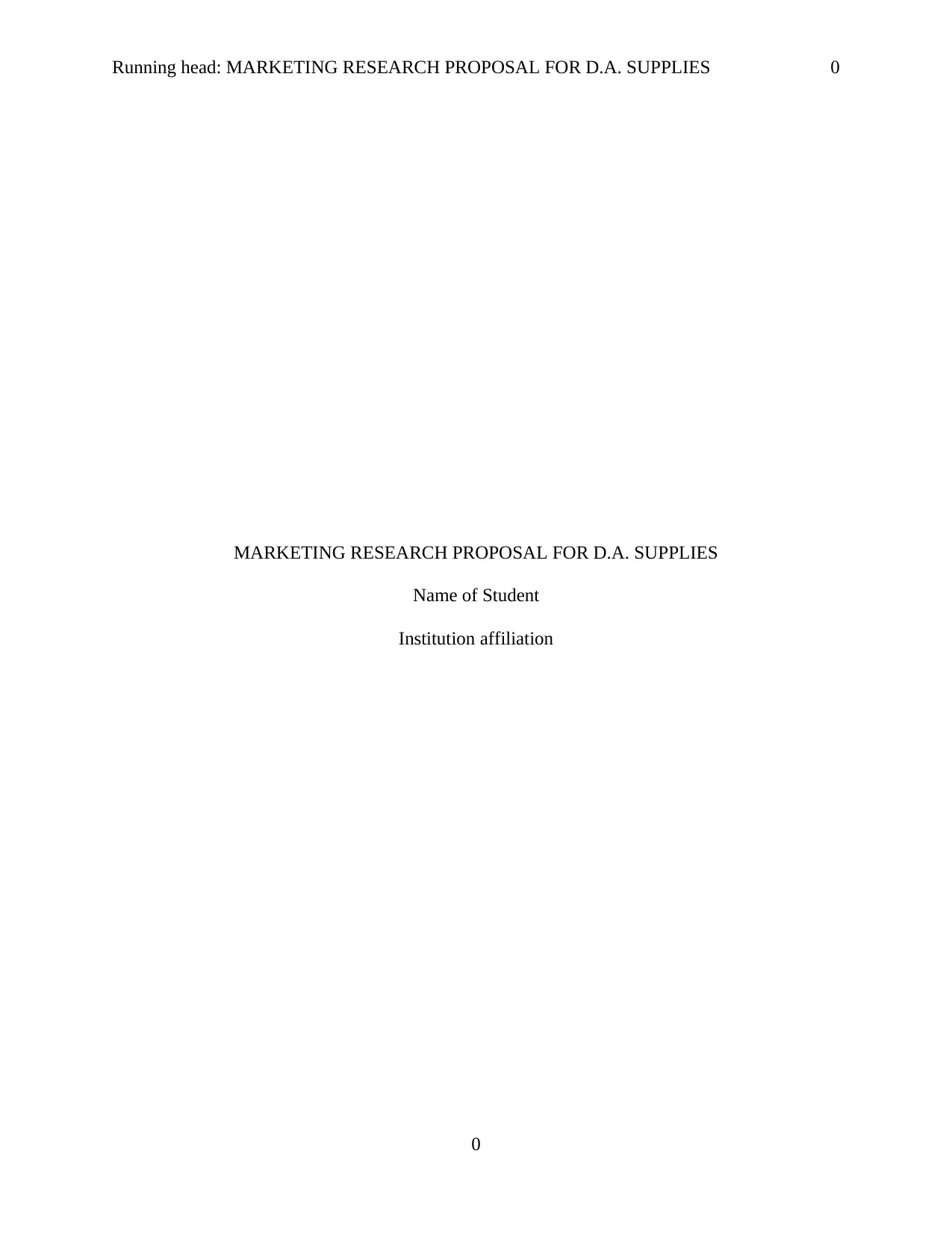
Running head: MARKETING RESEARCH PROPOSAL FOR D.A. SUPPLIES 0
MARKETING RESEARCH PROPOSAL FOR D.A. SUPPLIES
Name of Student
Institution affiliation
0
MARKETING RESEARCH PROPOSAL FOR D.A. SUPPLIES
Name of Student
Institution affiliation
0
Paraphrase This Document
Need a fresh take? Get an instant paraphrase of this document with our AI Paraphraser
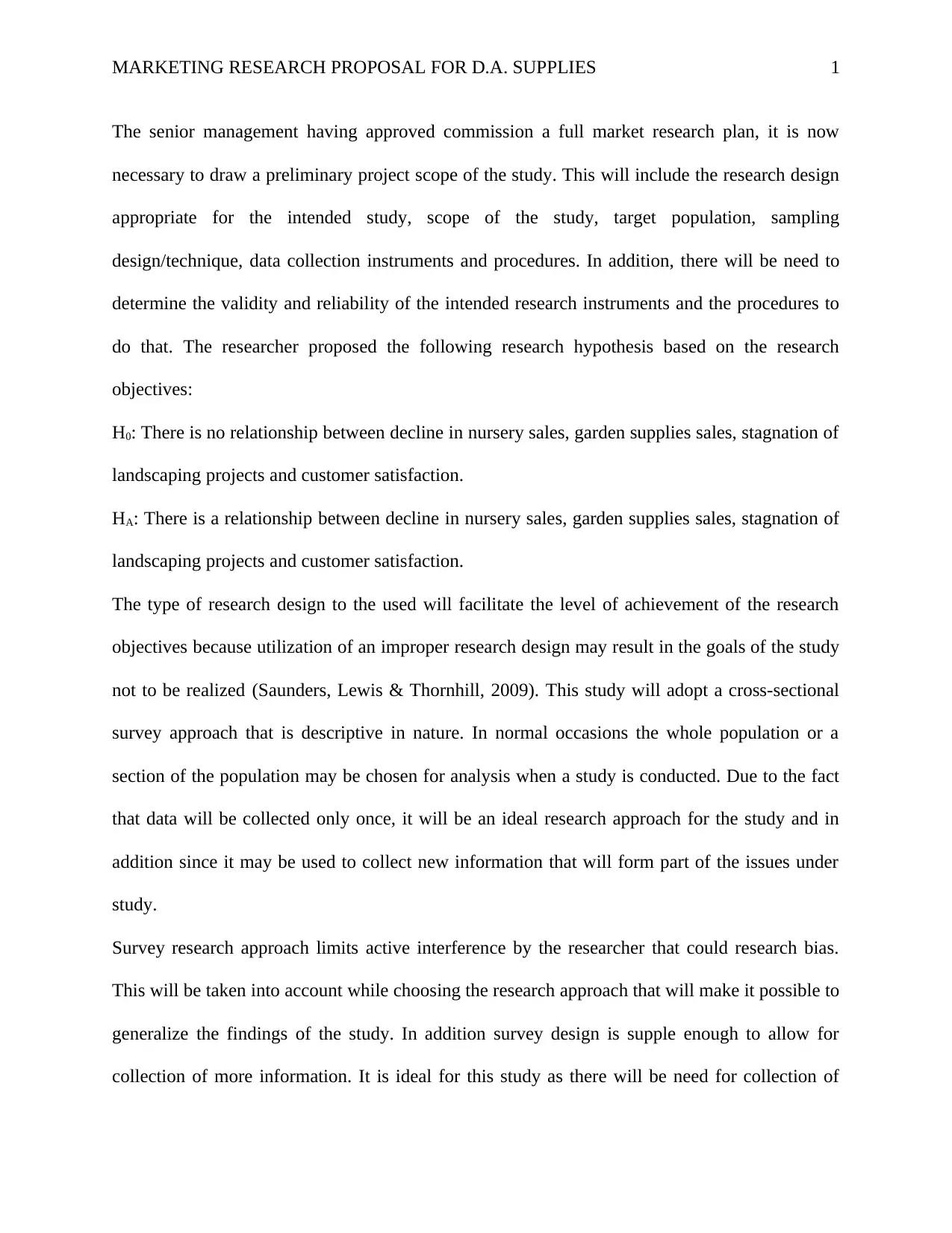
MARKETING RESEARCH PROPOSAL FOR D.A. SUPPLIES 1
The senior management having approved commission a full market research plan, it is now
necessary to draw a preliminary project scope of the study. This will include the research design
appropriate for the intended study, scope of the study, target population, sampling
design/technique, data collection instruments and procedures. In addition, there will be need to
determine the validity and reliability of the intended research instruments and the procedures to
do that. The researcher proposed the following research hypothesis based on the research
objectives:
H0: There is no relationship between decline in nursery sales, garden supplies sales, stagnation of
landscaping projects and customer satisfaction.
HA: There is a relationship between decline in nursery sales, garden supplies sales, stagnation of
landscaping projects and customer satisfaction.
The type of research design to the used will facilitate the level of achievement of the research
objectives because utilization of an improper research design may result in the goals of the study
not to be realized (Saunders, Lewis & Thornhill, 2009). This study will adopt a cross-sectional
survey approach that is descriptive in nature. In normal occasions the whole population or a
section of the population may be chosen for analysis when a study is conducted. Due to the fact
that data will be collected only once, it will be an ideal research approach for the study and in
addition since it may be used to collect new information that will form part of the issues under
study.
Survey research approach limits active interference by the researcher that could research bias.
This will be taken into account while choosing the research approach that will make it possible to
generalize the findings of the study. In addition survey design is supple enough to allow for
collection of more information. It is ideal for this study as there will be need for collection of
The senior management having approved commission a full market research plan, it is now
necessary to draw a preliminary project scope of the study. This will include the research design
appropriate for the intended study, scope of the study, target population, sampling
design/technique, data collection instruments and procedures. In addition, there will be need to
determine the validity and reliability of the intended research instruments and the procedures to
do that. The researcher proposed the following research hypothesis based on the research
objectives:
H0: There is no relationship between decline in nursery sales, garden supplies sales, stagnation of
landscaping projects and customer satisfaction.
HA: There is a relationship between decline in nursery sales, garden supplies sales, stagnation of
landscaping projects and customer satisfaction.
The type of research design to the used will facilitate the level of achievement of the research
objectives because utilization of an improper research design may result in the goals of the study
not to be realized (Saunders, Lewis & Thornhill, 2009). This study will adopt a cross-sectional
survey approach that is descriptive in nature. In normal occasions the whole population or a
section of the population may be chosen for analysis when a study is conducted. Due to the fact
that data will be collected only once, it will be an ideal research approach for the study and in
addition since it may be used to collect new information that will form part of the issues under
study.
Survey research approach limits active interference by the researcher that could research bias.
This will be taken into account while choosing the research approach that will make it possible to
generalize the findings of the study. In addition survey design is supple enough to allow for
collection of more information. It is ideal for this study as there will be need for collection of
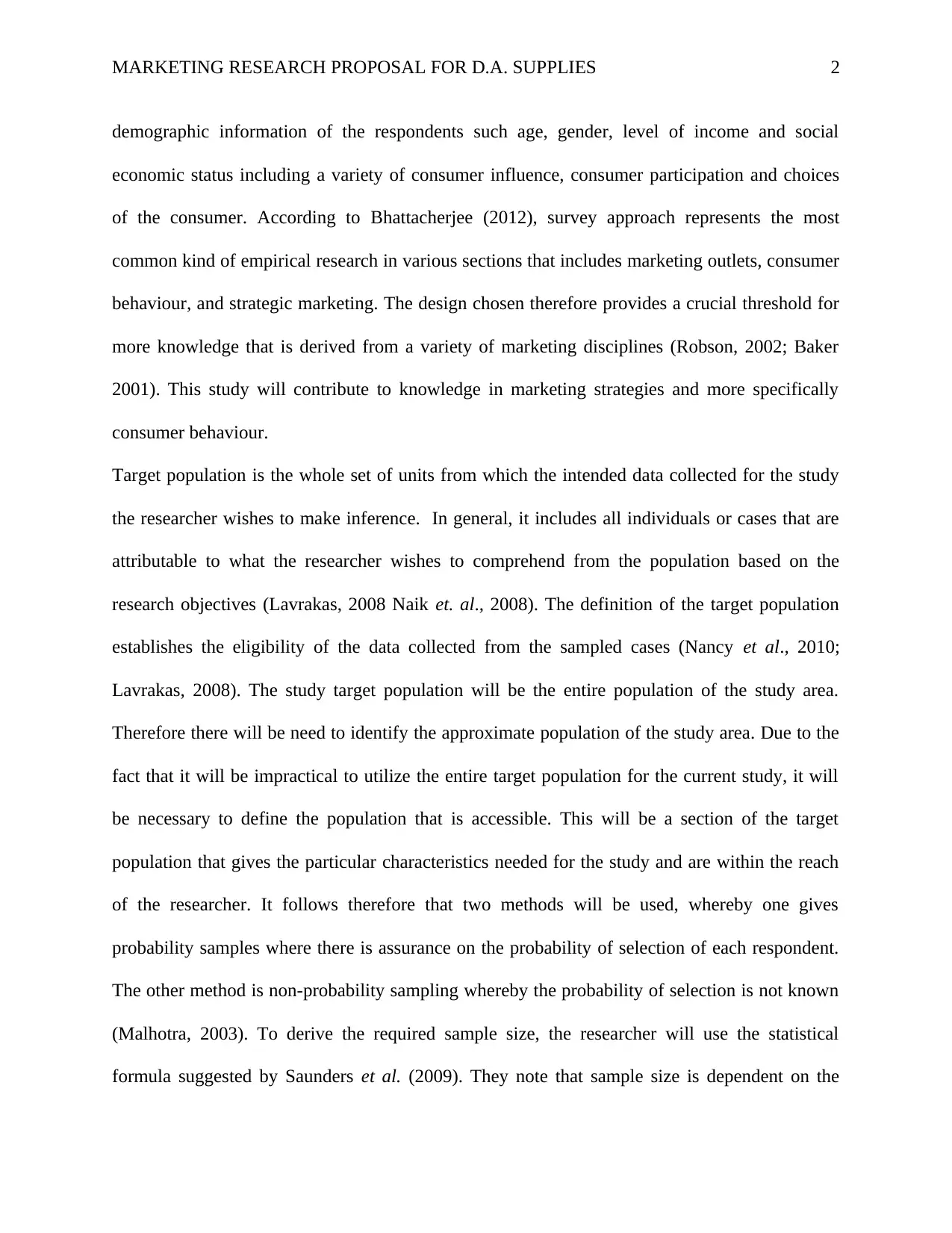
MARKETING RESEARCH PROPOSAL FOR D.A. SUPPLIES 2
demographic information of the respondents such age, gender, level of income and social
economic status including a variety of consumer influence, consumer participation and choices
of the consumer. According to Bhattacherjee (2012), survey approach represents the most
common kind of empirical research in various sections that includes marketing outlets, consumer
behaviour, and strategic marketing. The design chosen therefore provides a crucial threshold for
more knowledge that is derived from a variety of marketing disciplines (Robson, 2002; Baker
2001). This study will contribute to knowledge in marketing strategies and more specifically
consumer behaviour.
Target population is the whole set of units from which the intended data collected for the study
the researcher wishes to make inference. In general, it includes all individuals or cases that are
attributable to what the researcher wishes to comprehend from the population based on the
research objectives (Lavrakas, 2008 Naik et. al., 2008). The definition of the target population
establishes the eligibility of the data collected from the sampled cases (Nancy et al., 2010;
Lavrakas, 2008). The study target population will be the entire population of the study area.
Therefore there will be need to identify the approximate population of the study area. Due to the
fact that it will be impractical to utilize the entire target population for the current study, it will
be necessary to define the population that is accessible. This will be a section of the target
population that gives the particular characteristics needed for the study and are within the reach
of the researcher. It follows therefore that two methods will be used, whereby one gives
probability samples where there is assurance on the probability of selection of each respondent.
The other method is non-probability sampling whereby the probability of selection is not known
(Malhotra, 2003). To derive the required sample size, the researcher will use the statistical
formula suggested by Saunders et al. (2009). They note that sample size is dependent on the
demographic information of the respondents such age, gender, level of income and social
economic status including a variety of consumer influence, consumer participation and choices
of the consumer. According to Bhattacherjee (2012), survey approach represents the most
common kind of empirical research in various sections that includes marketing outlets, consumer
behaviour, and strategic marketing. The design chosen therefore provides a crucial threshold for
more knowledge that is derived from a variety of marketing disciplines (Robson, 2002; Baker
2001). This study will contribute to knowledge in marketing strategies and more specifically
consumer behaviour.
Target population is the whole set of units from which the intended data collected for the study
the researcher wishes to make inference. In general, it includes all individuals or cases that are
attributable to what the researcher wishes to comprehend from the population based on the
research objectives (Lavrakas, 2008 Naik et. al., 2008). The definition of the target population
establishes the eligibility of the data collected from the sampled cases (Nancy et al., 2010;
Lavrakas, 2008). The study target population will be the entire population of the study area.
Therefore there will be need to identify the approximate population of the study area. Due to the
fact that it will be impractical to utilize the entire target population for the current study, it will
be necessary to define the population that is accessible. This will be a section of the target
population that gives the particular characteristics needed for the study and are within the reach
of the researcher. It follows therefore that two methods will be used, whereby one gives
probability samples where there is assurance on the probability of selection of each respondent.
The other method is non-probability sampling whereby the probability of selection is not known
(Malhotra, 2003). To derive the required sample size, the researcher will use the statistical
formula suggested by Saunders et al. (2009). They note that sample size is dependent on the
⊘ This is a preview!⊘
Do you want full access?
Subscribe today to unlock all pages.

Trusted by 1+ million students worldwide
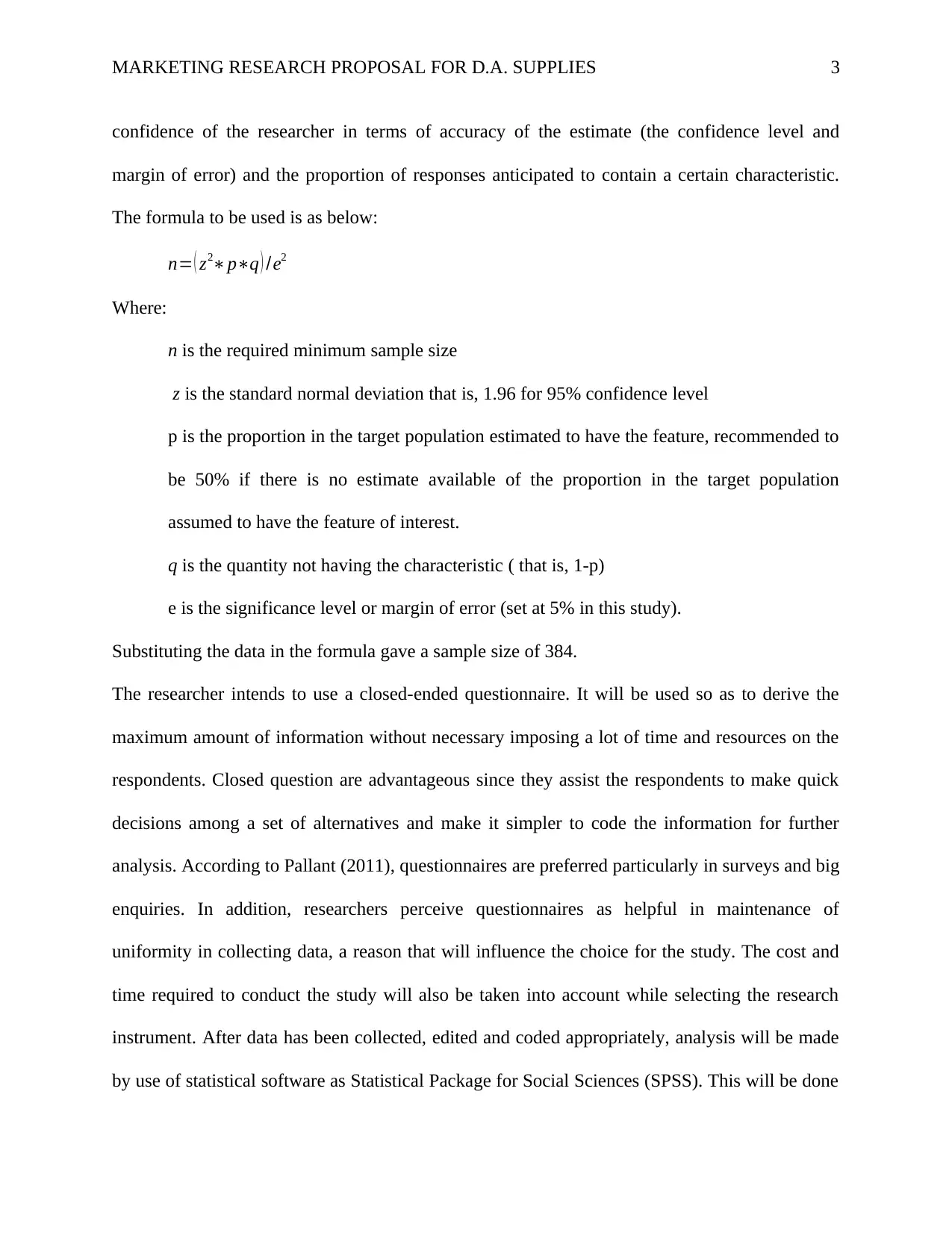
MARKETING RESEARCH PROPOSAL FOR D.A. SUPPLIES 3
confidence of the researcher in terms of accuracy of the estimate (the confidence level and
margin of error) and the proportion of responses anticipated to contain a certain characteristic.
The formula to be used is as below:
n= ( z2∗p∗q ) /e2
Where:
n is the required minimum sample size
z is the standard normal deviation that is, 1.96 for 95% confidence level
p is the proportion in the target population estimated to have the feature, recommended to
be 50% if there is no estimate available of the proportion in the target population
assumed to have the feature of interest.
q is the quantity not having the characteristic ( that is, 1-p)
e is the significance level or margin of error (set at 5% in this study).
Substituting the data in the formula gave a sample size of 384.
The researcher intends to use a closed-ended questionnaire. It will be used so as to derive the
maximum amount of information without necessary imposing a lot of time and resources on the
respondents. Closed question are advantageous since they assist the respondents to make quick
decisions among a set of alternatives and make it simpler to code the information for further
analysis. According to Pallant (2011), questionnaires are preferred particularly in surveys and big
enquiries. In addition, researchers perceive questionnaires as helpful in maintenance of
uniformity in collecting data, a reason that will influence the choice for the study. The cost and
time required to conduct the study will also be taken into account while selecting the research
instrument. After data has been collected, edited and coded appropriately, analysis will be made
by use of statistical software as Statistical Package for Social Sciences (SPSS). This will be done
confidence of the researcher in terms of accuracy of the estimate (the confidence level and
margin of error) and the proportion of responses anticipated to contain a certain characteristic.
The formula to be used is as below:
n= ( z2∗p∗q ) /e2
Where:
n is the required minimum sample size
z is the standard normal deviation that is, 1.96 for 95% confidence level
p is the proportion in the target population estimated to have the feature, recommended to
be 50% if there is no estimate available of the proportion in the target population
assumed to have the feature of interest.
q is the quantity not having the characteristic ( that is, 1-p)
e is the significance level or margin of error (set at 5% in this study).
Substituting the data in the formula gave a sample size of 384.
The researcher intends to use a closed-ended questionnaire. It will be used so as to derive the
maximum amount of information without necessary imposing a lot of time and resources on the
respondents. Closed question are advantageous since they assist the respondents to make quick
decisions among a set of alternatives and make it simpler to code the information for further
analysis. According to Pallant (2011), questionnaires are preferred particularly in surveys and big
enquiries. In addition, researchers perceive questionnaires as helpful in maintenance of
uniformity in collecting data, a reason that will influence the choice for the study. The cost and
time required to conduct the study will also be taken into account while selecting the research
instrument. After data has been collected, edited and coded appropriately, analysis will be made
by use of statistical software as Statistical Package for Social Sciences (SPSS). This will be done
Paraphrase This Document
Need a fresh take? Get an instant paraphrase of this document with our AI Paraphraser
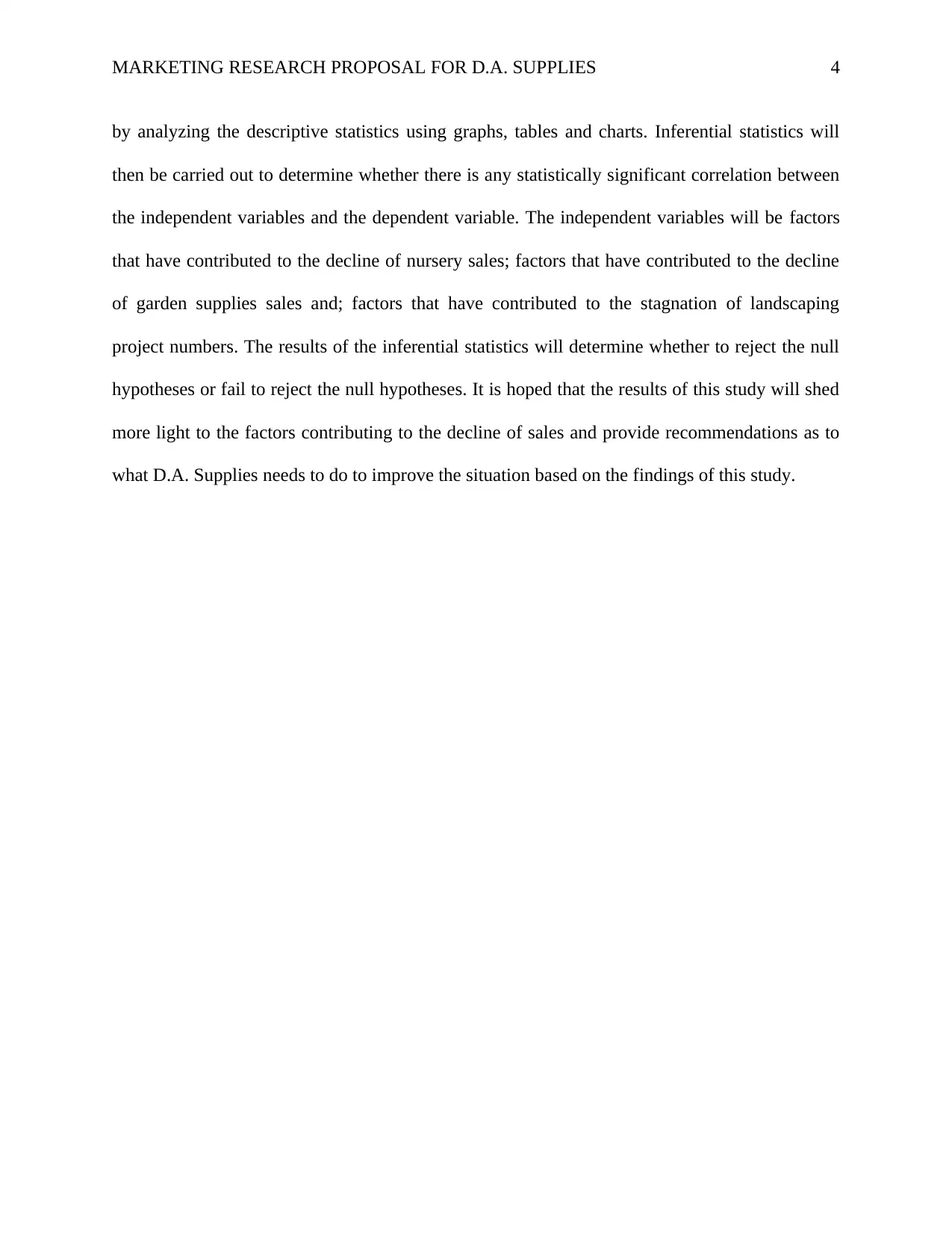
MARKETING RESEARCH PROPOSAL FOR D.A. SUPPLIES 4
by analyzing the descriptive statistics using graphs, tables and charts. Inferential statistics will
then be carried out to determine whether there is any statistically significant correlation between
the independent variables and the dependent variable. The independent variables will be factors
that have contributed to the decline of nursery sales; factors that have contributed to the decline
of garden supplies sales and; factors that have contributed to the stagnation of landscaping
project numbers. The results of the inferential statistics will determine whether to reject the null
hypotheses or fail to reject the null hypotheses. It is hoped that the results of this study will shed
more light to the factors contributing to the decline of sales and provide recommendations as to
what D.A. Supplies needs to do to improve the situation based on the findings of this study.
by analyzing the descriptive statistics using graphs, tables and charts. Inferential statistics will
then be carried out to determine whether there is any statistically significant correlation between
the independent variables and the dependent variable. The independent variables will be factors
that have contributed to the decline of nursery sales; factors that have contributed to the decline
of garden supplies sales and; factors that have contributed to the stagnation of landscaping
project numbers. The results of the inferential statistics will determine whether to reject the null
hypotheses or fail to reject the null hypotheses. It is hoped that the results of this study will shed
more light to the factors contributing to the decline of sales and provide recommendations as to
what D.A. Supplies needs to do to improve the situation based on the findings of this study.
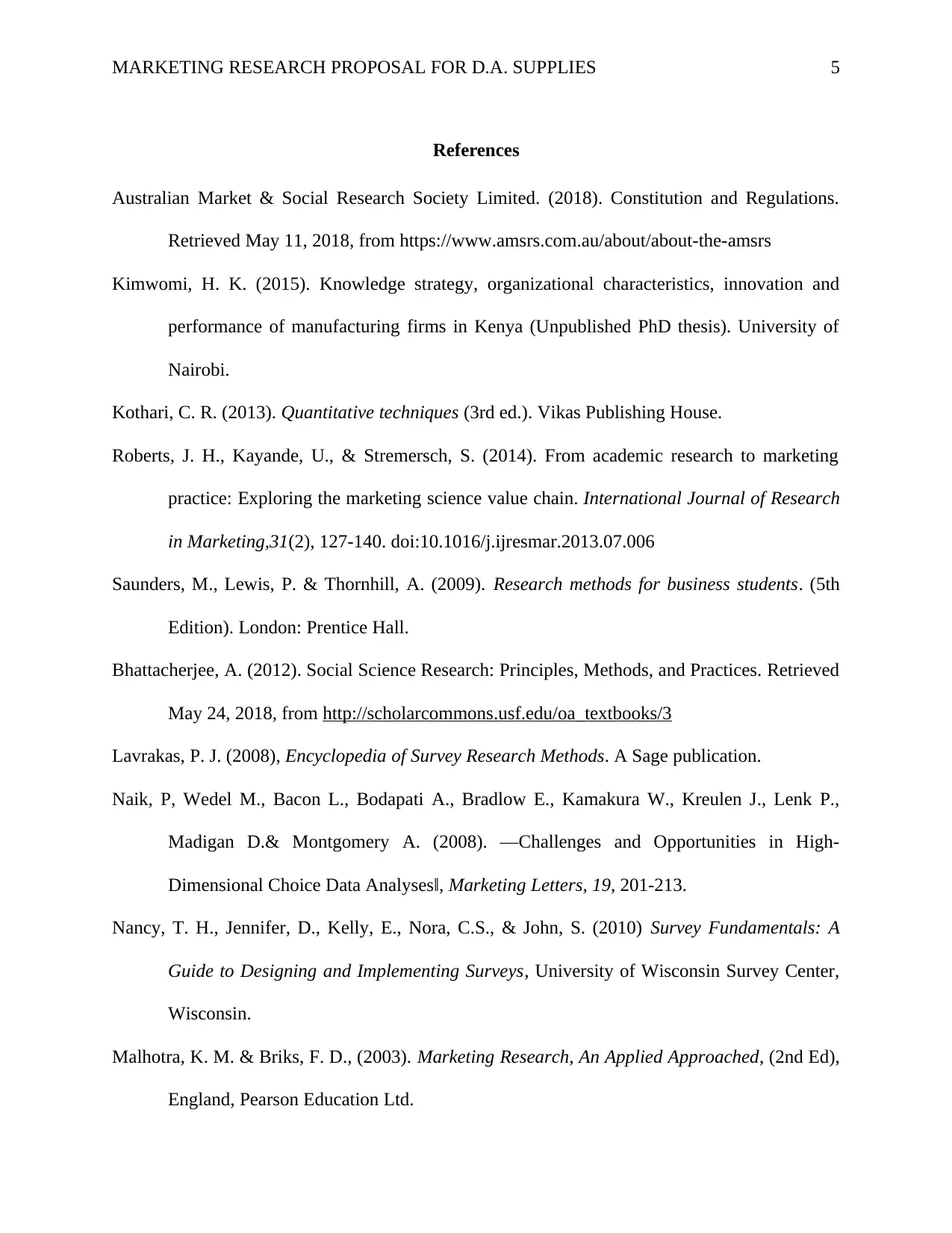
MARKETING RESEARCH PROPOSAL FOR D.A. SUPPLIES 5
References
Australian Market & Social Research Society Limited. (2018). Constitution and Regulations.
Retrieved May 11, 2018, from https://www.amsrs.com.au/about/about-the-amsrs
Kimwomi, H. K. (2015). Knowledge strategy, organizational characteristics, innovation and
performance of manufacturing firms in Kenya (Unpublished PhD thesis). University of
Nairobi.
Kothari, C. R. (2013). Quantitative techniques (3rd ed.). Vikas Publishing House.
Roberts, J. H., Kayande, U., & Stremersch, S. (2014). From academic research to marketing
practice: Exploring the marketing science value chain. International Journal of Research
in Marketing,31(2), 127-140. doi:10.1016/j.ijresmar.2013.07.006
Saunders, M., Lewis, P. & Thornhill, A. (2009). Research methods for business students. (5th
Edition). London: Prentice Hall.
Bhattacherjee, A. (2012). Social Science Research: Principles, Methods, and Practices. Retrieved
May 24, 2018, from http://scholarcommons.usf.edu/oa_textbooks/3
Lavrakas, P. J. (2008), Encyclopedia of Survey Research Methods. A Sage publication.
Naik, P, Wedel M., Bacon L., Bodapati A., Bradlow E., Kamakura W., Kreulen J., Lenk P.,
Madigan D.& Montgomery A. (2008). ―Challenges and Opportunities in High-
Dimensional Choice Data Analyses‖, Marketing Letters, 19, 201-213.
Nancy, T. H., Jennifer, D., Kelly, E., Nora, C.S., & John, S. (2010) Survey Fundamentals: A
Guide to Designing and Implementing Surveys, University of Wisconsin Survey Center,
Wisconsin.
Malhotra, K. M. & Briks, F. D., (2003). Marketing Research, An Applied Approached, (2nd Ed),
England, Pearson Education Ltd.
References
Australian Market & Social Research Society Limited. (2018). Constitution and Regulations.
Retrieved May 11, 2018, from https://www.amsrs.com.au/about/about-the-amsrs
Kimwomi, H. K. (2015). Knowledge strategy, organizational characteristics, innovation and
performance of manufacturing firms in Kenya (Unpublished PhD thesis). University of
Nairobi.
Kothari, C. R. (2013). Quantitative techniques (3rd ed.). Vikas Publishing House.
Roberts, J. H., Kayande, U., & Stremersch, S. (2014). From academic research to marketing
practice: Exploring the marketing science value chain. International Journal of Research
in Marketing,31(2), 127-140. doi:10.1016/j.ijresmar.2013.07.006
Saunders, M., Lewis, P. & Thornhill, A. (2009). Research methods for business students. (5th
Edition). London: Prentice Hall.
Bhattacherjee, A. (2012). Social Science Research: Principles, Methods, and Practices. Retrieved
May 24, 2018, from http://scholarcommons.usf.edu/oa_textbooks/3
Lavrakas, P. J. (2008), Encyclopedia of Survey Research Methods. A Sage publication.
Naik, P, Wedel M., Bacon L., Bodapati A., Bradlow E., Kamakura W., Kreulen J., Lenk P.,
Madigan D.& Montgomery A. (2008). ―Challenges and Opportunities in High-
Dimensional Choice Data Analyses‖, Marketing Letters, 19, 201-213.
Nancy, T. H., Jennifer, D., Kelly, E., Nora, C.S., & John, S. (2010) Survey Fundamentals: A
Guide to Designing and Implementing Surveys, University of Wisconsin Survey Center,
Wisconsin.
Malhotra, K. M. & Briks, F. D., (2003). Marketing Research, An Applied Approached, (2nd Ed),
England, Pearson Education Ltd.
⊘ This is a preview!⊘
Do you want full access?
Subscribe today to unlock all pages.

Trusted by 1+ million students worldwide

MARKETING RESEARCH PROPOSAL FOR D.A. SUPPLIES 6
Pallant, J. (2011). A Step by Step Guide to Data Analysis Using SPSS (4th Ed) Everbest Printing
Co. China
Pallant, J. (2011). A Step by Step Guide to Data Analysis Using SPSS (4th Ed) Everbest Printing
Co. China
1 out of 7
Related Documents
Your All-in-One AI-Powered Toolkit for Academic Success.
+13062052269
info@desklib.com
Available 24*7 on WhatsApp / Email
![[object Object]](/_next/static/media/star-bottom.7253800d.svg)
Unlock your academic potential
Copyright © 2020–2025 A2Z Services. All Rights Reserved. Developed and managed by ZUCOL.





